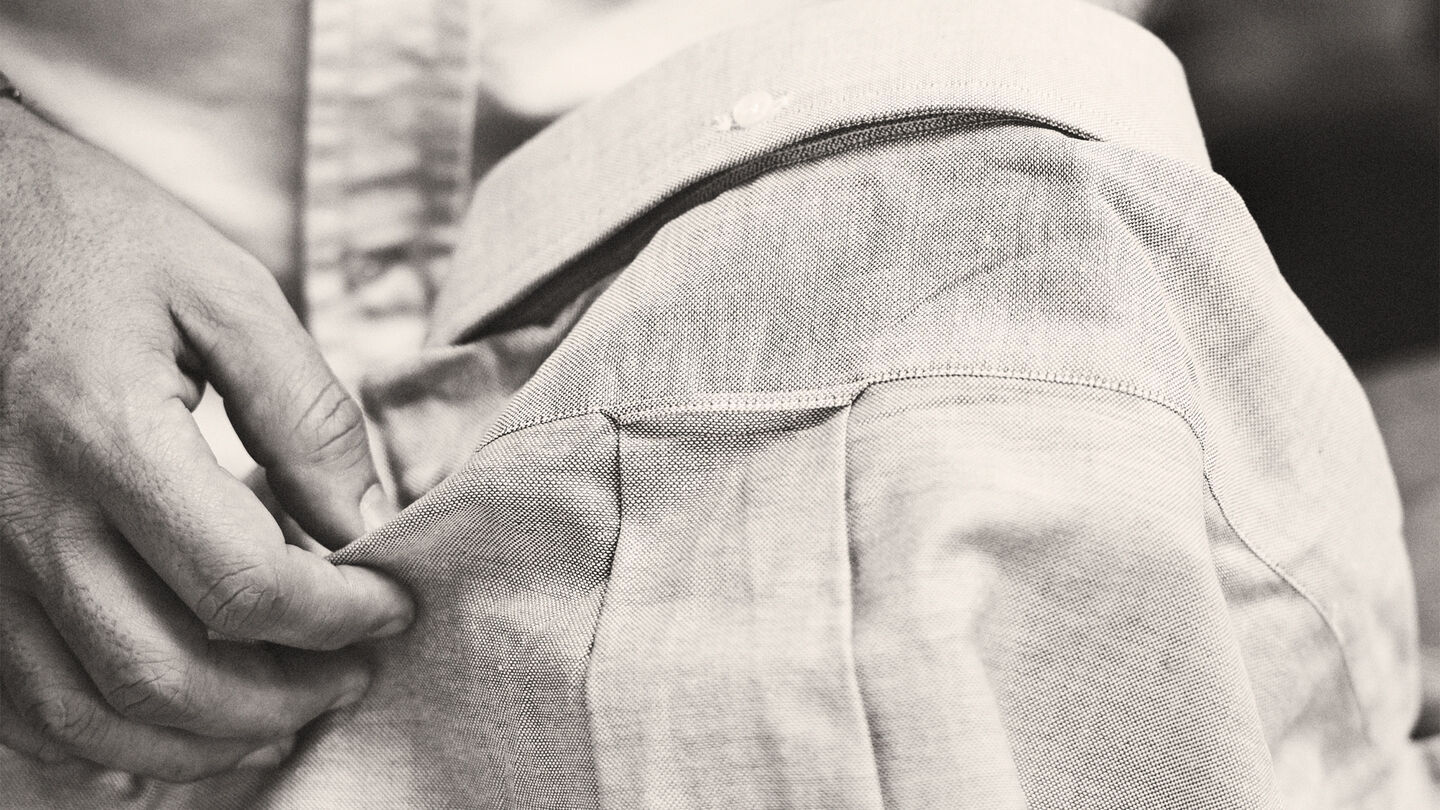GET EXTRA 5% OFF ON ALL PREPAID ORDERS!
THE GANT STORY
No future without an origin
There are a whole series of beautiful stories about the all-American brand GANT, with the story of its founding being perhaps the most beautiful. In 1914 Bernard Gantmacher came to New York from the Ukraine, 17 years old, full of hopes and dreams. Manhattan's Garment District was America's textile hub at the time. Here, in one of the countless textile factories, Bernard Gantmacher learned the craft of a collar cutter, studied on the side, completed a college education and got to know and love the buttonhole seamstress Rebecca Rose. When the First World War broke out, Bernard went to France with the US Army. After completing his military service, he returned to New York with a new thirst for success. There he and a partner founded a shirt tailoring company as a supplier in the New York borough of Brooklyn. With increasing success, the company moved to nearby New Haven, where the GANT brand was founded. The Gantmachers now made shirts, mainly for American brands such as Brooks Brothers. They had a small "G" sewn into each shirt, framed in a diamond. An unmistakable signet that should very quickly become a synonym for uncompromising quality. The shirts were so popular that the demand increased more and more across the country. This prompted Bernard Gantmacher to found the GANT brand in 1949 with his wife Rebecca and their two young sons Marty and Elliot, who learned the tailoring trade from scratch and who have now graduated from the University of Connecticut. The Gantmachers now made shirts, mainly for American brands such as Brooks Brothers. They had a small "G" sewn into each shirt, framed in a diamond. An unmistakable signet that should very quickly become a synonym for uncompromising quality. The shirts were so popular that the demand increased more and more across the country. This prompted Bernard Gantmacher to found the GANT brand in 1949 with his wife Rebecca and their two young sons Marty and Elliot, who learned the tailoring trade from scratch and who have now graduated from the University of Connecticut. The Gantmachers now made shirts, mainly for American brands such as Brooks Brothers. They had a small "G" sewn into each shirt, framed in a diamond. An unmistakable signet that should very quickly become a synonym for uncompromising quality. The shirts were so popular that the demand increased more and more across the country. This prompted Bernard Gantmacher to found the GANT brand in 1949 with his wife Rebecca and their two young sons Marty and Elliot, who learned the tailoring trade from scratch and who have now graduated from the University of Connecticut. which should very quickly become a synonym for uncompromising quality. The shirts were so popular that the demand increased more and more across the country. This prompted Bernard Gantmacher to found the GANT brand in 1949 with his wife Rebecca and their two young sons Marty and Elliot, who learned the tailoring trade from scratch and who have now graduated from the University of Connecticut. which should very quickly become a synonym for uncompromising quality. The shirts were so popular that the demand increased more and more across the country. This prompted Bernard Gantmacher to found the GANT brand in 1949 with his wife Rebecca and their two young sons Marty and Elliot, who learned the tailoring trade from scratch and who have now graduated from the University of Connecticut.
The own brand was a success right from the start and its casualness and sportiness made it the archetype of American sportswear. Characterized by the lifestyle on campus and the east coast as well as the Ivy League - a league of elite universities that stood for academic excellence, sport, prestige and tradition. A term that defined a new, casual style that would change American fashion forever. This style became known as the Ivy League or East Coast look and GANT adopted this new fashion direction. GANT experimented with different fabrics and new cuts, contrasted the rather pale colors of the 50s with fresh, strong colors and patterns such as checks and stripes and thus played a leading role in the creation of this new, fresh look. The family also played a key role in the development of the button-down shirt. Once worn only by English polo players, the first American model came from the Brooks Brothers in the 1920s. With craftsmanship and an unbroken passion for details, Bernard Gantmacher ultimately developed the perfect GANT button-down shirt from this model, which should quickly become an icon of the still young brand. It became an essential part of the Ivy League look. A piece of clothing that no style-conscious American in the 50s and 60s could do without. For everyone who was looking for quality, the button-down shirt was now synonymous with GANT. the first American model came from the Brooks Brothers from the 1920s. With craftsmanship and an unbroken passion for details, Bernard Gantmacher ultimately developed the perfect GANT button-down shirt from this model, which should quickly become an icon of the still young brand. It became an essential part of the Ivy League look. A piece of clothing that no style-conscious American in the 50s and 60s could do without. For everyone who was looking for quality, the button-down shirt was now synonymous with GANT. the first American model came from the Brooks Brothers from the 1920s. With craftsmanship and an unbroken passion for details, Bernard Gantmacher ultimately developed the perfect GANT button-down shirt from this model, which should quickly become an icon of the still young brand. It became an essential part of the Ivy League look. A piece of clothing that no style-conscious American in the 50s and 60s could do without. For everyone who was looking for quality, the button-down shirt was now synonymous with GANT. which should quickly develop into an icon of the still young brand. It became an essential part of the Ivy League look. A piece of clothing that no style-conscious American in the 50s and 60s could do without. For everyone who was looking for quality, the button-down shirt was now synonymous with GANT. which should quickly develop into an icon of the still young brand. It became an essential part of the Ivy League look. A piece of clothing that no style-conscious American in the 50s and 60s could do without. For everyone who was looking for quality, the button-down shirt was now synonymous with GANT.
But the perfect button-down collar wasn't the only detail that GANT had perfected. Other small details that accentuated the GANT shirt were the so-called loose loop. A loop in the back of the shirt, by which it could be hung in the changing room or locker without creasing. A detail that even became a fixture in the Ivy League's dating rituals: if you entered into a committed relationship, the student removed the loose loop from his shirt. Another typical detail was the box pleat in the back of the shirt, which gave the wearer more freedom of movement, or the collar button on the back, which held the tie in place and thus prevented the collar from sliding up.
All of this is the basis of this American success story. The button-down shirt that GANT helped achieve its global breakthrough in the 50s and made the brand as such immortal. Today, GANT is not only the premium lifestyle brand with the richest tradition and the only one that comes from a Schneider family, but an entirely international company. In over six decades, the former men's shirt brand has developed into an extensive collection for men, women and children. Even home accessories, shoes, watches, glasses, etc. can be found all over the world today under the GANT brand.
The GANT collections still include shirts and blouses that bear the signature of Bernard Gantmacher and have made his ideas immortal. His ideas, his preference for casual and sportswear and his passion for the lifestyle of the American East Coast are also what make all collections unmistakable today. The GANT brand still feels obliged to this tradition, always connected with fashionable topicality, authenticity, passion, innovation and the current zeitgeist, today and in the future.
Having a legacy and a true story creates authenticity and credibility. A valuable foundation for a brand. After all, how are you supposed to know where you're going if you don't know where you're from? Tradition can be this modern.



